Q&A Blog | World Orangutan Day
Alison Ashbury
Check out this World Orangutan Day Q&A blog with Dr. Alison Ashbury as she talks about her experiences being an Orangutan researcher and science writer for the Department for the Ecology of Animal Societies at the Max Plank Institute of Animal Behaviour!
Q&A Blog
Published August 19, 2021
All images provided courtesy of Dr. Alison Ashbury.
Why did you choose to focus your career around researching orangutans? When did you realize this was the path for you?
I was always really interested in animals and loved to read National Geographic, and watch documentaries about wild animals as a kid. Orangutans were always my favorite; I think I was drawn to their simple, quiet, solitary nature. As a shy and introverted kid, I felt a certain kinship with them, and I could never get enough of reading about them or seeing them on TV. Every couple of years, we would visit the Toronto Zoo, and the orangutans were always my favorite part of the day. However, it never occurred to me to make an actual career out of this until my first year of university. I took an Anthropology course as an elective, and about half way through the semester, we started a primatology unit. My jaw dropped to the floor – studying monkeys and apes, even orangutans, could be job? I changed my major to Anthropology the next day.
Who did you look up to or view as a role model/mentor?
I haven’t had a single specific role model or mentor, but rather I’ve been lucky enough to have some incredible teachers and colleagues throughout my education and career. I had a primatology professor during my undergrad who really saw potential in me and who encouraged me to pursue my interest in studying orangutans. He helped to guide me through the process of getting my first field position, and was a sounding board for me during some more challenging points in my education. I’ve also been lucky enough to work with, be supervised by, and study alongside some really incredible people – many, women – whose intelligence, authenticity, curiosity, and creativity have brought out the best in me, helped me to find my voice, and fostered my potential as a researcher.
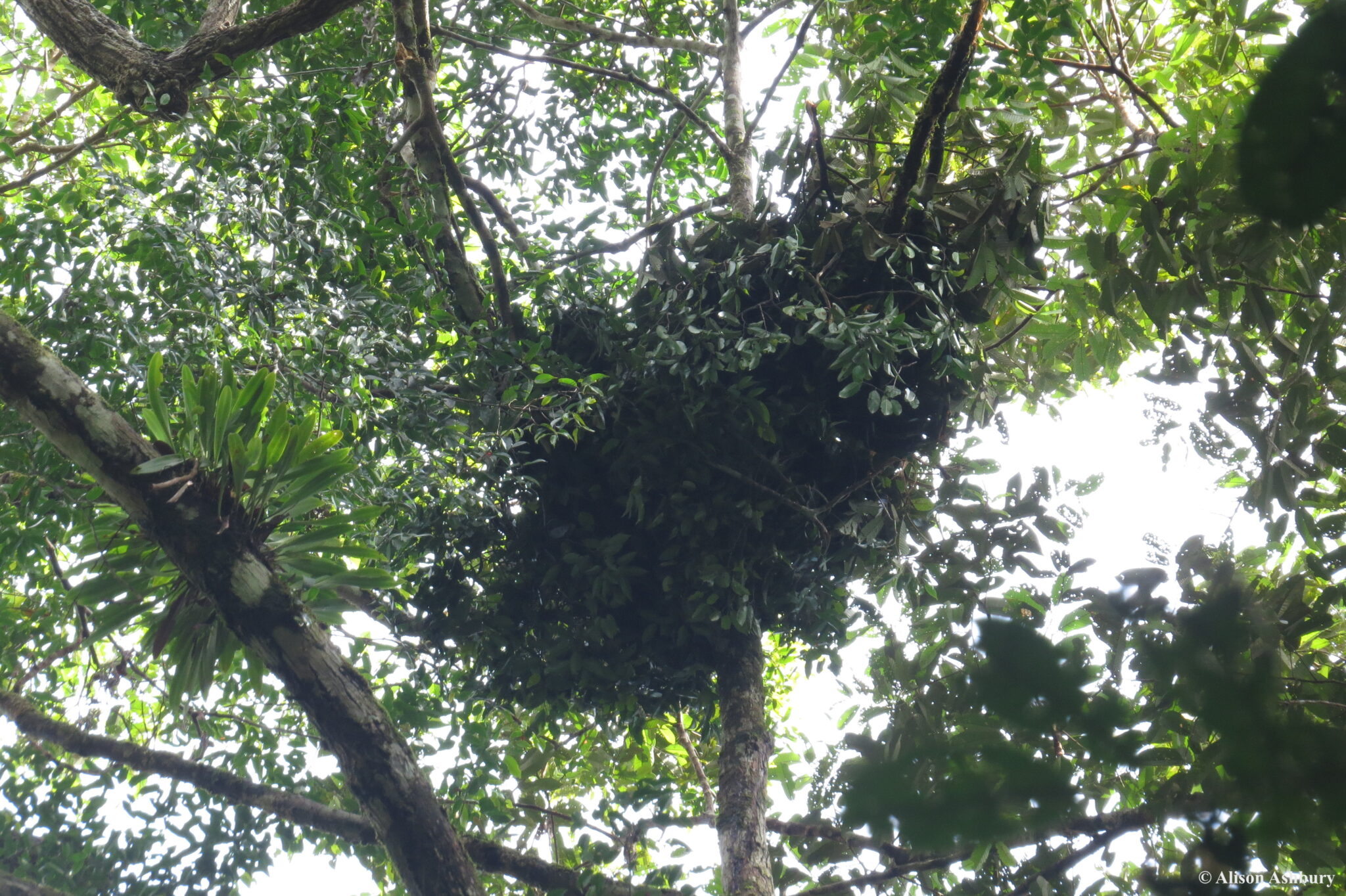
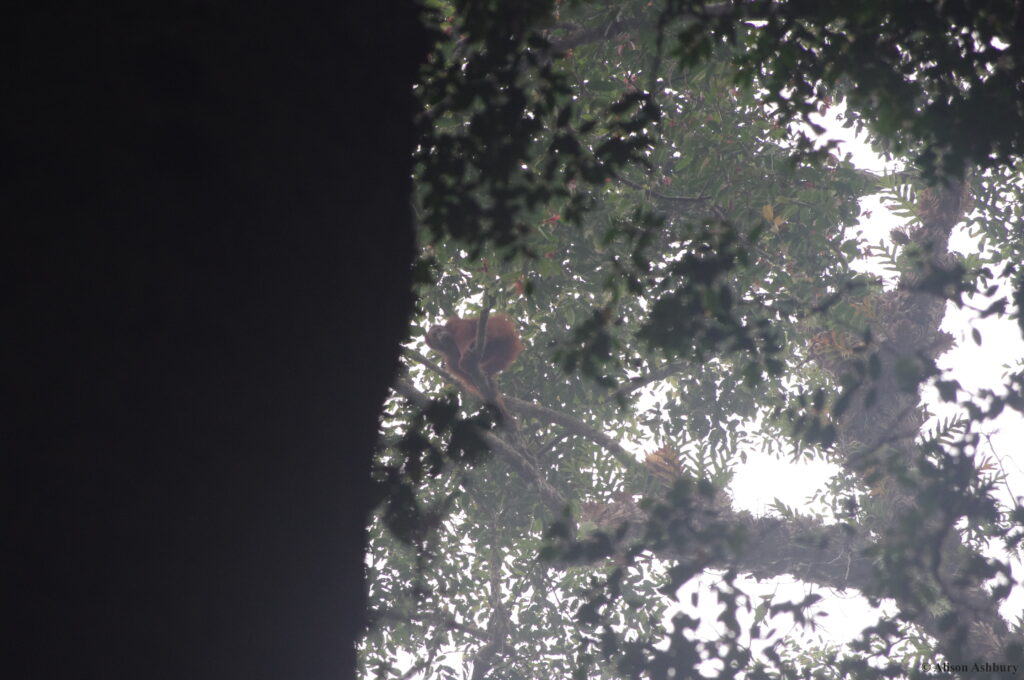
Left: “An orangutan nest, as we usually see them, from the ground. There is a large male orangutan in this nest (completely out of sight).” Right: A young male orangutan, up in the forest canopy.
As a researcher, what in your opinion are the essential qualities needed to observe orangutans successfully?
I think there is a certain duality to the qualities that make somebody well suited to studying orangutans. On one hand, a person needs to have endless patience and a generally flexible attitude. No aspect of studying orangutans can be rushed, and rarely does everything go smoothly. It’s essential to be able to go with the flow, problem solve, and make the best of a situation that isn’t ideal or planned. On the other hand, a person needs to have a really keen attention to detail and be very organized, motivated, and hard-working. Everything from getting research permit applications compiled and submitted, to actually collecting data in the field, can be really challenging, requires a lot of hard work and precision, and must be done correctly. It can be difficult to find the balance between these two sides of yourself; to not fall into a groove that is too relaxed – so that you’re not actually doing enough or moving things along as they need to be – or too intense – so you’re driving yourself crazy trying to do things perfectly in a situation where that just isn’t possible. Developing these two sides of yourself – especially, learning whichever side comes less naturally – and then balancing them day-to-day, is a big part of orangutan field research.
What challenges did you encounter during your research work and working with this intelligent and solitary group of mammals?
I think some of the most consistent challenges I have faced while studying orangutans stem from the remoteness of the field sites where I’ve worked. The sites where I’ve done most of my fieldwork have all been accessible only via a long boat ride, or a very, very long car ride on treacherous roads – far from shops, and towns, and electricity, and cell phone reception. This poses a lot of basic logistical challenges – actually getting all of our gear and supplies into the sites, restocking food every few weeks, charging laptops and camera batteries, getting sick or injured people out of the site to medical help, etc – as well as psychological challenges of not being able to easily pick up the phone and call somebody you love when you’ve had a bad day, or call for help when something goes wrong, or quickly google how to fix something that’s broken. I’ve always been lucky enough to work with an awesome team of Indonesian field assistants and researchers, and often also a couple of other students or researchers from North America or Europe, but even with the companionship and support of a good team, the field can still be a lonely and isolating place to live.
Another consistently challenging aspect is the physical exertion of data collection. Because orangutans can be so hard to find, and because we want to observe as much of their behavior as possible, we always do nest-to-nest follows once we have found an orangutan. This means that we need to be at the orangutan’s nest before it wakes up (i.e. we need to hike out to the nest, which could take up to 2 hours, and get there by 5:30am) and then we need to follow the orangutan – through acidic peat swamps, across deep rivers, up and over steep ridges, through dense prickly brush or swarms of biting insects, in the rain or the blazing hot sun, whatever the habitat includes – until he or she settles down into their night nest, sometimes as late as 7pm (and then we need to hike home, maybe another 2 hours). And we do this while trying to get a good view of the orangutan – which may be 20 or 30 meters high in the trees – and collecting constant detailed notes about their behavior – what they’re eating, how they’re eating it, where they’re going and how they’re moving, who they’re with and what they’re doing together, etc. Then we do it all again the next day. And again, and again. There is nothing more rewarding or awe-inspiring than following a wild orangutan, but it is physically and mentally exhausting.
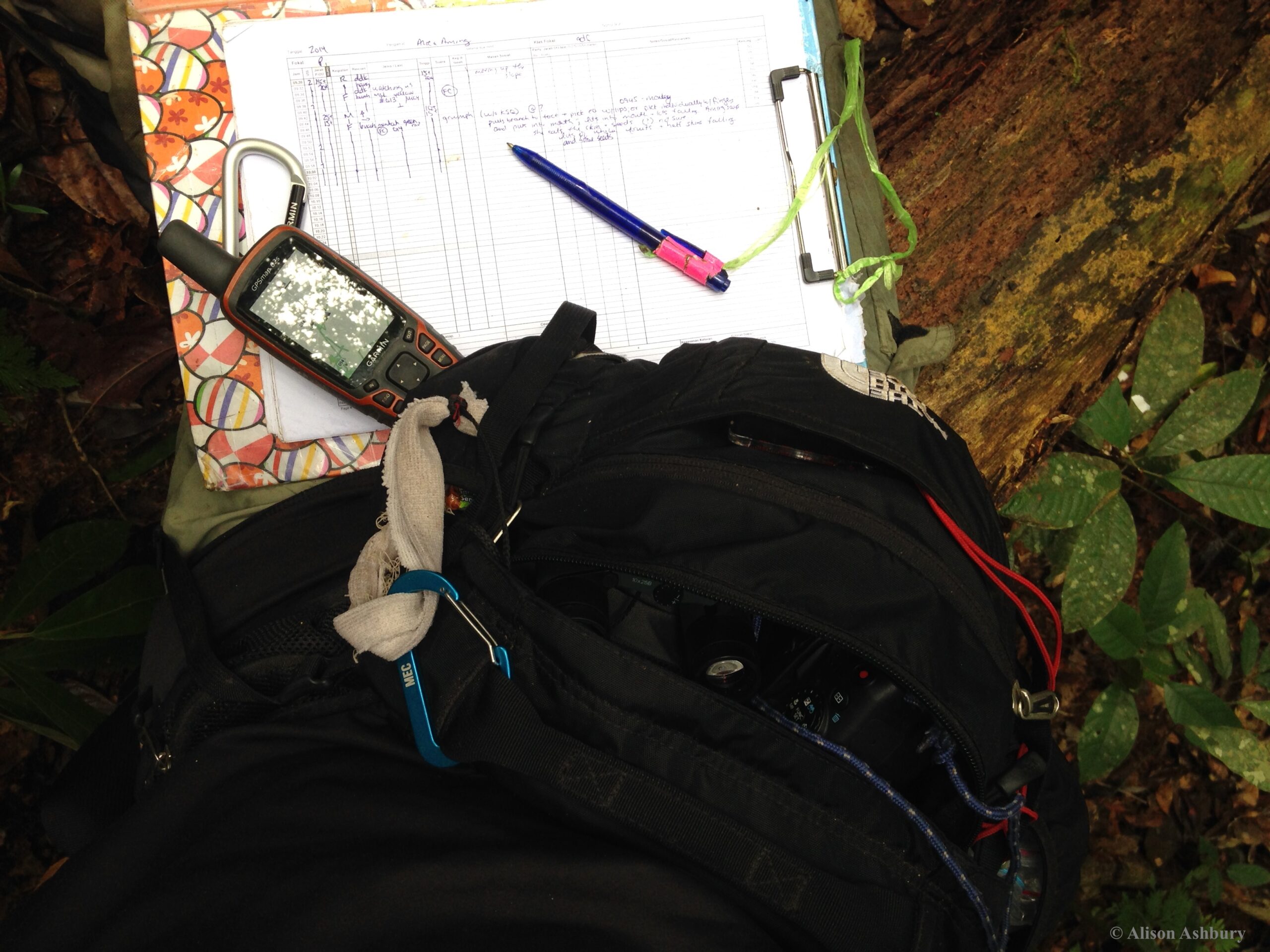
“When I follow orangutans, I like to carry my GPS unit, compass, binoculars, and camera in a large fanny pack on my front, so that I have quick access to them. I also wear a backpack with water, food, and other equipment and supplies that I don’t need to access so many times during the day.”
After spending countless hours studying the behaviour and ecology of orangutans in Indonesian Borneo, can you recollect a time where a particular orangutan behaviour stood out?
I once had the incredible fortune to be able to look into a mother orangutan’s nest, and watch her settle for the evening with her infant daughter.
Being able to watch wild orangutans in their nests is really, really, rare. Every night, an orangutan sleeps in a nest that they build up in the forest canopy. An orangutan chooses a tree, and bends and breaks branches, pulling them in towards themselves and essentially weaving a platform, about 10 to 25 meters high in the canopy, out of leafy branches. The whole process can take as long as 20 minutes, and the nests usually end up being really big and bushy. For us, on the ground, following the orangutan, about half-way through the nest-building process, we can’t see the orangutan anymore. We can hear them continuing to build the nest, and see their hands and arms come out to grab branches, and we can maybe see that they shift their weight as they lie down – but, essentially, once an orangutan builds a nest, our detailed observation of their behavior ends. And, especially with mothers who have small infants with them, we can assume that they are interacting and nursing in the nest – often we can see movement, some shaking of the nest and the branches around it, maybe an arm or a leg stick out, then disappear back in, and we know they’re not asleep yet – but we can’t actually see what is going on.
On one occasion, when I was studying orangutans at a site that had really steep hilly topography, we were following an adult female, Pi and her new infant baby – this was just the third or fourth day that we’d been following Pi since we’d first found her with her new baby (rather than pregnant, as we’d seen her previously) – and she built a nest in a position such that we could climb up a nearby slope and see right across into her nest, from about 25 meters away. I cannot explain the feeling of watching Pi in her nest with her baby, Pu. My assistant and I had tears running down our cheeks, our binoculars glued to our faces, watching as Pi gently groomed Pu, and kissed the top of her head, and moved her to nurse from one side to the other. It was the most intimate, beautiful thing I’ve ever seen. There was a relaxed vulnerability about them that I’d never seen in a wild orangutan before, outside of the nest. It was so incredibly special, to momentarily have this small window into a part of their lives that we’d never actually been able to observe before. We stood there watching them, in awe-struck silence, until it was so dark that we couldn’t see anything anymore.

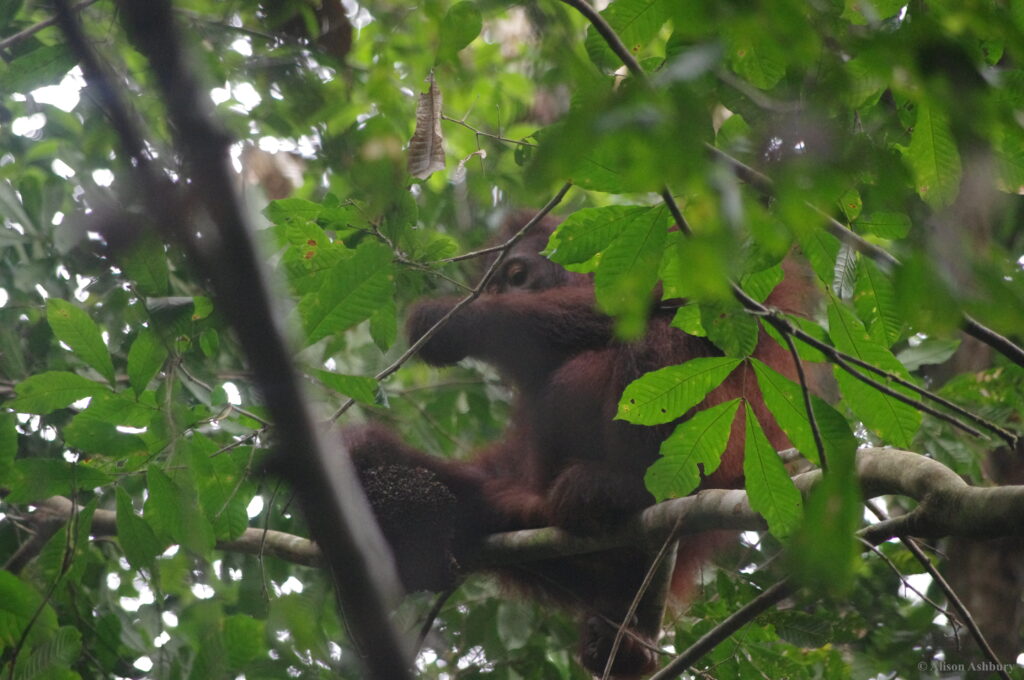
Left: “Pi and Pu in their night nest. Pi is lying on her back, and using her right foot to pull Pu from her side, onto her tummy.” Right: “A young orangutan feeds on termites from a termite nest. Orangutans have really varied diets, including fruit, leaves, flowers, and insects.”
In what way do orangutans provide wisdom to human beings when displaying a solution-oriented, patient and respectful mindset?I
I think one of the main things we can learn from orangutans is to slow down and appreciate the simple things in life. Orangutans live quiet lives – they move slowly and deliberately through the forest, searching for food, listening to and watching their surroundings, occasionally visiting with their friends. I think that we sometimes lose sight of the value of slowing down, maintaining healthy social boundaries, and being thoughtful and introspective about what we do, what we say, and what we consume. I think that orangutans embody the idea of appreciating the simple things in life – a good meal, a comfy bed – and doing so in a quiet and thoughtful way.
What inspirational message would you give young women to inspire and encourage them to pursue a career in the field of STEM?
Take up space. So often as women, we’re encouraged to be small – both metaphorically (“Don’t be a bossy know-it-all.”) and literally (“Don’t be fat.”) – and I think it’s so important for girls and women, of all ages, to push back against these ideas and to hold space. This can be as simple as speaking up in class, or more complex, like fighting against the real structural barriers that exist for women pursuing careers in STEM fields. I think that these barriers are sometimes indirect and devious, such that when women encounter them, we internalize them as our own shortcomings (“maybe if I’d worked harder, maybe if I were smarter”), and we try to get out of the way. It can be really challenging to actually see these barriers for what they are, systemic obstacles and structural biases that impede our progress in STEM fields, and to continue to ask questions, use our voices, and take up space. And, as part of a larger conversation, we need to start flipping this question around and rather ask “How can the STEM fields remove access barriers for girls and young women – as well as other excluded and marginalized groups – and what more can these fields do to retain these folks through their careers?”
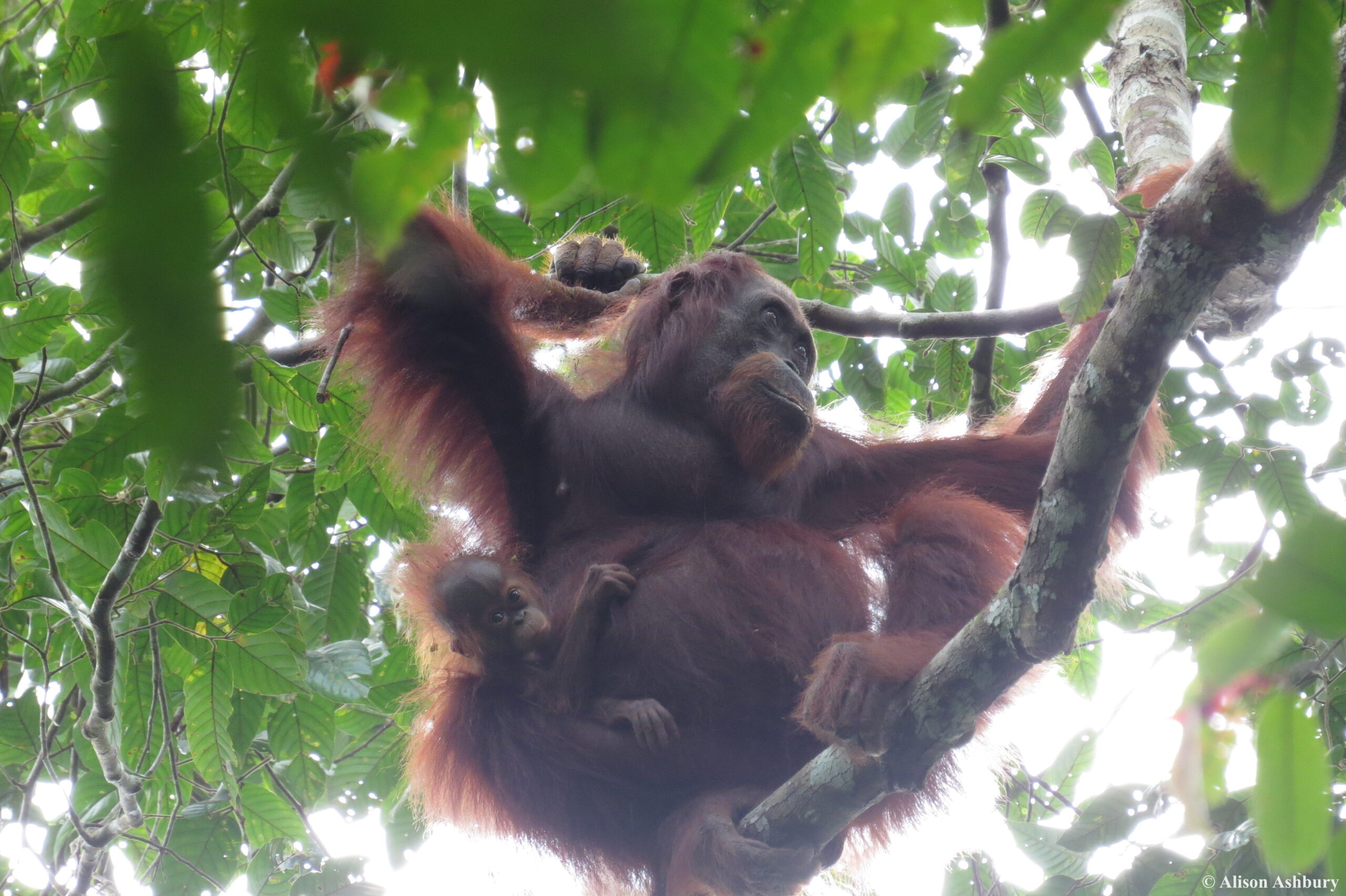
“Pi and Pu, sitting on a branch. Infant orangutans are often curious about observers and watch us while we watch them.”
You support orangutan conservation efforts through different organizations and initiatives. What advice would you give the youth to make efforts in saving the population of critically endangered orangutans?
I think one of the main things that people can do to help save orangutans is to support the efforts of conservation organizations that are doing good work, on the ground, in orangutan habitat countries (Indonesia and Malaysia). There are so many different threats to orangutans, from illegal poaching and logging, to the legal clearing of forest for palm oil plantations and coal mines, to rampant habitat loss caused by unstoppable forest fires which get worse every year due to climate change. Different areas need different solutions and there are great organizations that work closely with local communities to develop and carry out these solutions. Some organizations that I support include: the SUAQ program (www.suaq.org), Orangutan Foundation International (www.orangutan.org), and CORE Borneo (www.coreborneo.com), as I’ve seen first-hand the work that they do and how effective it is. These groups can always use more support.
I think it’s also important to remember that the forces that threaten orangutan populations are not unique or specific: protecting orangutans requires a lot of the same efforts that are needed to protect other endangered species, to help marginalized people, and to stop climate change. Petition your government representatives to put people before profits, promote social welfare initiatives, buy products made of sustainable materials and made by people who are paid living wages, know where your bank is investing your money, and do whatever you can to fight climate change. Helping to make the world a better place for all of its inhabitants will ultimately help orangutans, too.
